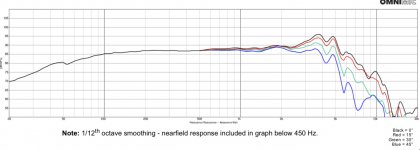I recently made a 2-way bookshelf as an homage to the venerable LS3/5A. However, I implemented a crossover well above the usual 2.5kHz to 3.5kHz frequency normally used for 2 way speakers. I put the crossover at about 5.5kHz and used a modified inverted passive Harsch XO to achieve semi-transient perfect behavior and the resulting sound is so natural and great sounding. As the so-called “telephone” band that is so important is often described as frequencies from about 500Hz to 5kHz where most vocals, instruments, and soundstage spatial cues are contained in this frequency range. It would seem that the speaker I made might be called a Super Tweeter Assisted Fullrange Texhnology (STAFT) - the long lost brother of the FAST speaker. Some people like the WAW acronym vs FAST and mods have been going through all the threads and renaming them or adding WAW wherever they see FAST. So in that case, the acronym would be STAW or Super Tweeter Assisted Wideband (STAW). Whatever you like to call it, what I am noticing is that it produces a very natural lifelike sound with superb imaging and soundstage. So much so, I am building very special wooden cabinets for what was a foam core prototype.
Here is the measured frequency response showing the contributions from the woofer and the tweeter:
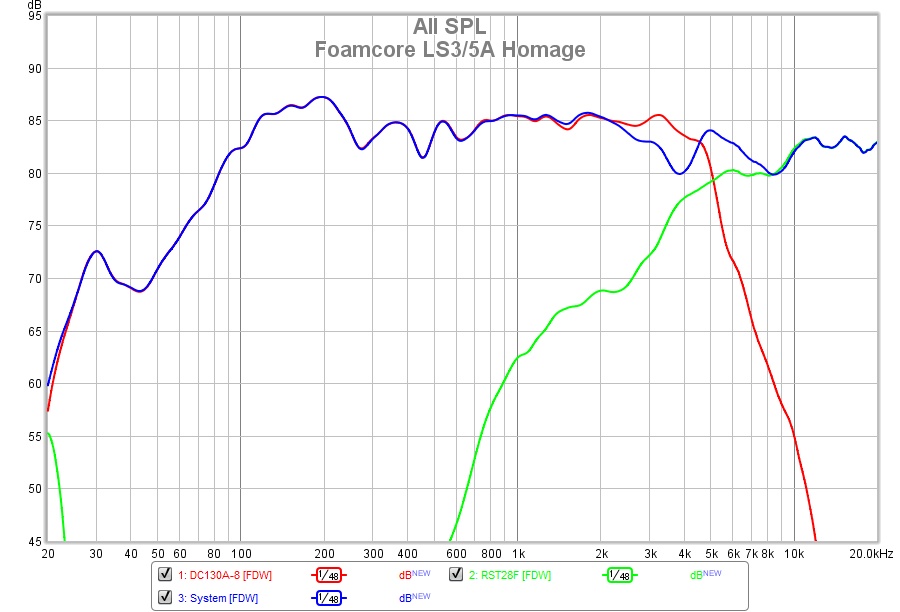
Here is the measured step response exhibiting a near right triangle shape indicative is a transient perfect speaker:

In this case, the woofer is really a wide bandwidth woofer capable of producing bass and mid range up to 5kHz and the tweeter is a conventional soft dome capable of crossing as low as 1.5kHz but I chose to do it at 5.5kHz. So the STAFT has the advantage of very nice highs and shimmer that many of us miss from a single cone fullrange driver. Even the some of the best and most highly regarded fullrange drivers like the Scanspeak 10F really only go up to about 16kHz. Whereas a true dome tweeter goes well above 20kHz. And the bass from a “midbass woofer”‘ is generally a lot better than the bass from a fullrange driver. So I suspect that this combo may just be the best of both worlds.
One other thing to note is that most natural sound sources like voice and instruments tend to lie either below or above the 5kHz to 7kHz range. Thus, the crossover doesn’t have to split the critical human voice or piano right in its most important (and audible) 1kHz to 3kHz region.
Here is the simple crossover:
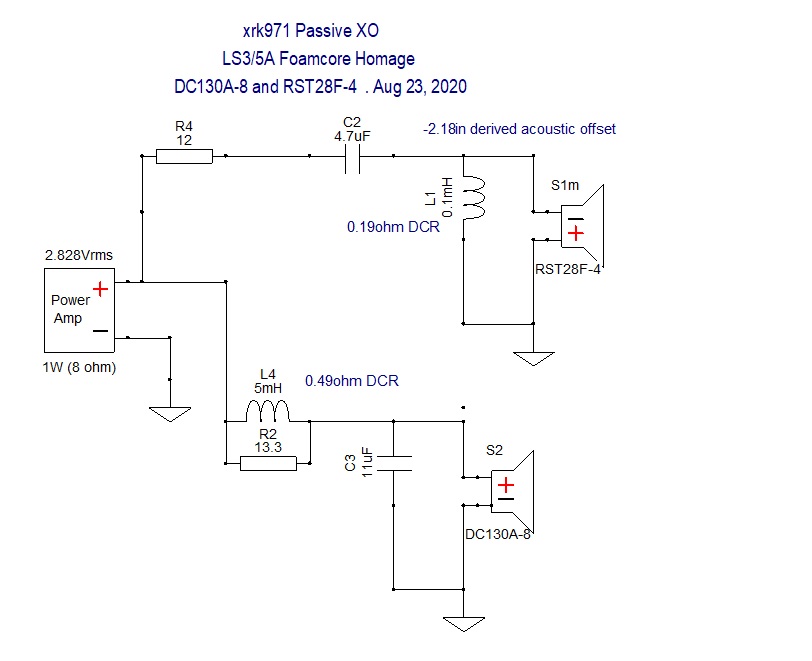
And this is the speaker implemented in foamcore:
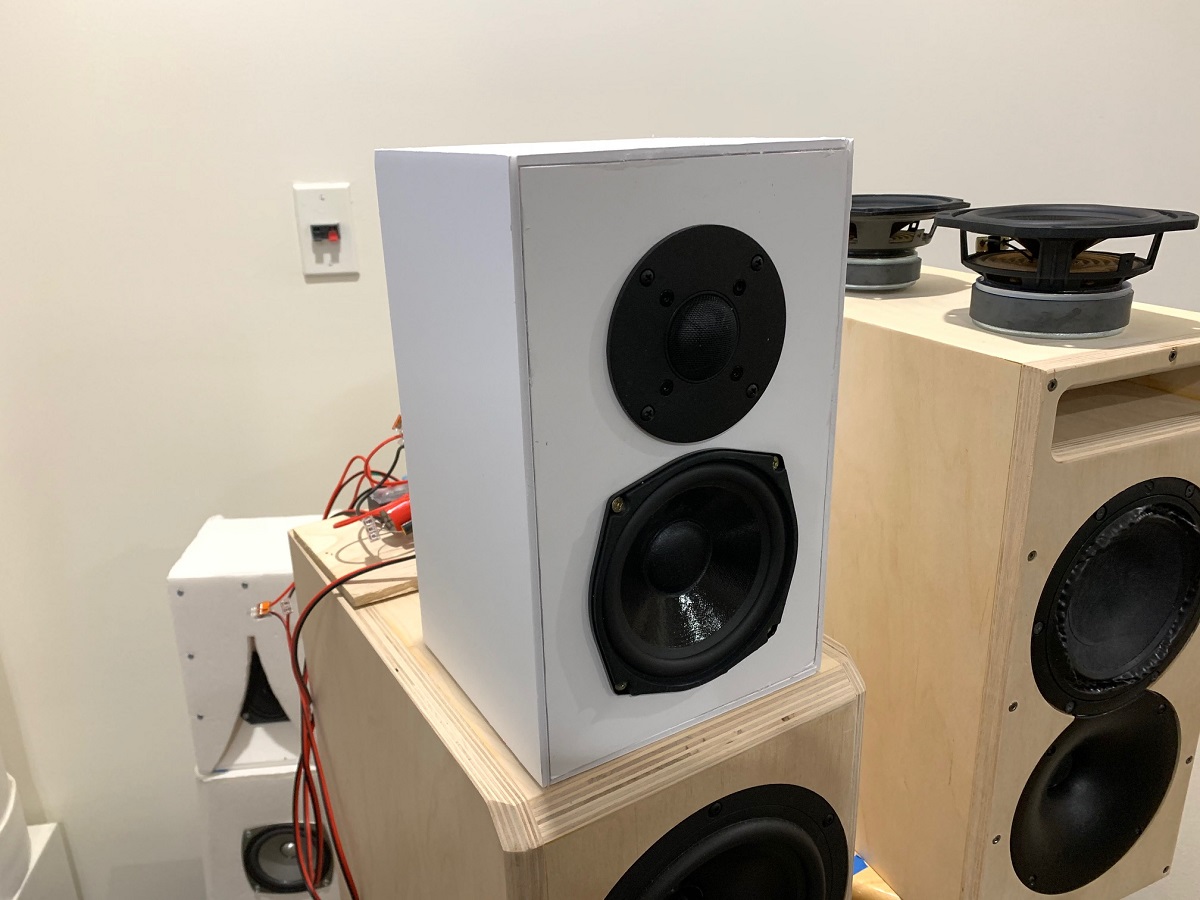
And a wooden version that will look something like this is being built:
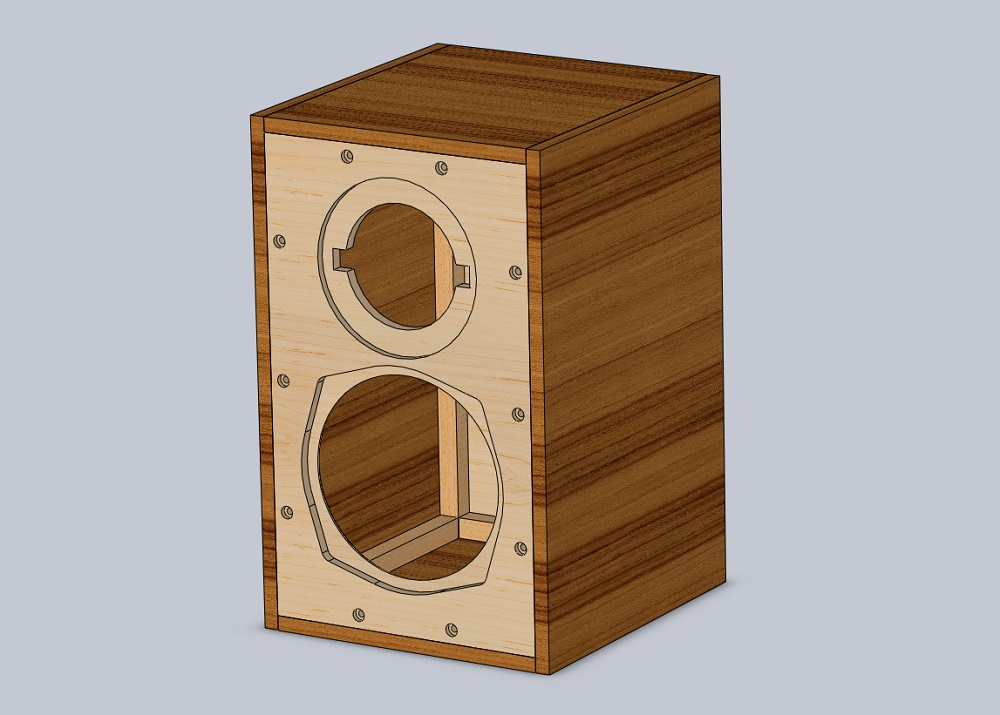
I have been listening to this as a nearfield monitor for several weeks now and really enjoying the sound. I love the precision soundstage and imaging. I like how natural it sounds. I like the dynamics and the presence of high hats and cymbals. The upper end response of the RST28F-4 tweeter is remarkably clean for a $37 tweeter. I think what also contributes to how clean the tweeter sounds is the very high crossover so that the cone doesn’t move much and this doesn’t distort. The midbass is a low cost DC130A-8 treated paper cone. It was chosen for its deeper bass reach in a small sealed cabinet vs the more expensive RS150 or RS150P variants from Dayton.
This speaker also has a very benign electrical impedance curve:
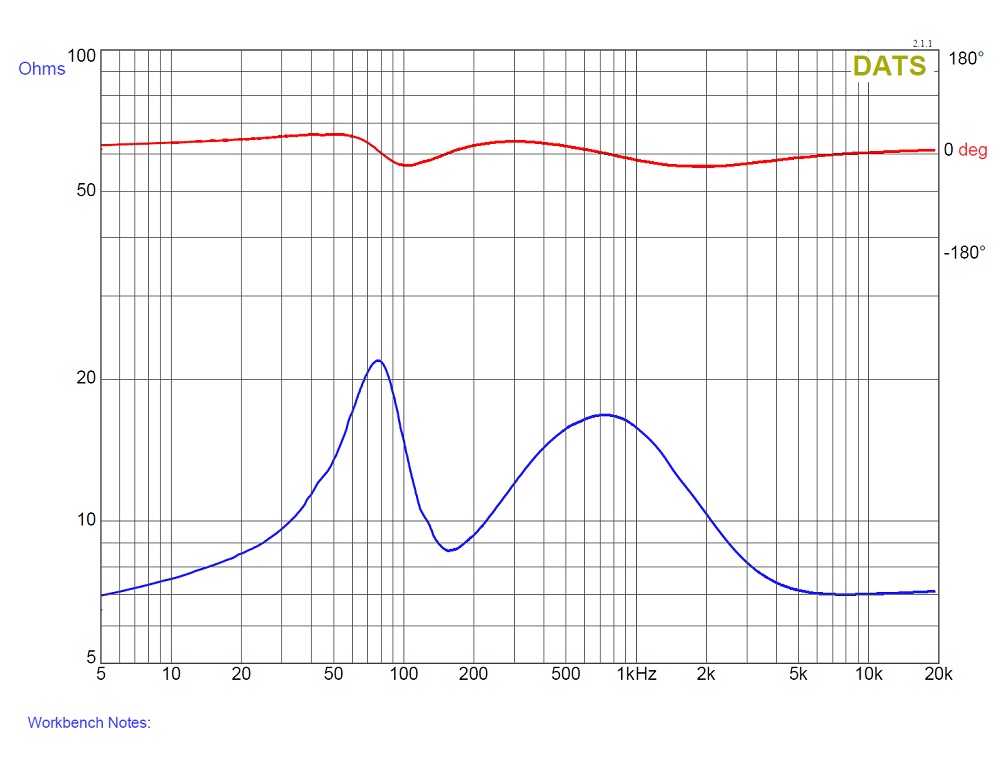
Definitely never drops below 7ohms and averages closer to nominal 10 to 12ohms and so is perfect for most amplifiers to easily drive.
So the question is, would a STAFT generally play most music better than a FAST? Maybe it depends on if you really like the sizzle of a true tweeter.
We have of course see large 8in or bigger fullrange drivers with a super tweeter assist
But what I am calling for here is to pick a good wide band midbass or woofer rather than a fullrange driver. Perhaps the RS225-8 and an RST28F-4 in a waveguide with a high XO would be a similar type of thing? A modification of this system
Might produce another STAFT type speaker:
Passive XO for Time-Aligned RS225-8 and RS28F in Waveguide
Here is the measured frequency response showing the contributions from the woofer and the tweeter:
Here is the measured step response exhibiting a near right triangle shape indicative is a transient perfect speaker:
In this case, the woofer is really a wide bandwidth woofer capable of producing bass and mid range up to 5kHz and the tweeter is a conventional soft dome capable of crossing as low as 1.5kHz but I chose to do it at 5.5kHz. So the STAFT has the advantage of very nice highs and shimmer that many of us miss from a single cone fullrange driver. Even the some of the best and most highly regarded fullrange drivers like the Scanspeak 10F really only go up to about 16kHz. Whereas a true dome tweeter goes well above 20kHz. And the bass from a “midbass woofer”‘ is generally a lot better than the bass from a fullrange driver. So I suspect that this combo may just be the best of both worlds.
One other thing to note is that most natural sound sources like voice and instruments tend to lie either below or above the 5kHz to 7kHz range. Thus, the crossover doesn’t have to split the critical human voice or piano right in its most important (and audible) 1kHz to 3kHz region.
Here is the simple crossover:
And this is the speaker implemented in foamcore:
And a wooden version that will look something like this is being built:
I have been listening to this as a nearfield monitor for several weeks now and really enjoying the sound. I love the precision soundstage and imaging. I like how natural it sounds. I like the dynamics and the presence of high hats and cymbals. The upper end response of the RST28F-4 tweeter is remarkably clean for a $37 tweeter. I think what also contributes to how clean the tweeter sounds is the very high crossover so that the cone doesn’t move much and this doesn’t distort. The midbass is a low cost DC130A-8 treated paper cone. It was chosen for its deeper bass reach in a small sealed cabinet vs the more expensive RS150 or RS150P variants from Dayton.
This speaker also has a very benign electrical impedance curve:
Definitely never drops below 7ohms and averages closer to nominal 10 to 12ohms and so is perfect for most amplifiers to easily drive.
So the question is, would a STAFT generally play most music better than a FAST? Maybe it depends on if you really like the sizzle of a true tweeter.
We have of course see large 8in or bigger fullrange drivers with a super tweeter assist
But what I am calling for here is to pick a good wide band midbass or woofer rather than a fullrange driver. Perhaps the RS225-8 and an RST28F-4 in a waveguide with a high XO would be a similar type of thing? A modification of this system
Might produce another STAFT type speaker:
Passive XO for Time-Aligned RS225-8 and RS28F in Waveguide
Last edited:
X,
Basically what you are asking for is a high bandwidth mid-bass driver to be coupled with a quality tweeter at higher XO points?
This would be more akin to a 2-way speaker system, albeit with different XO frequencies vs traditional.
Folks probably will consider the "beaming" of the larger driver and how the power response looks like when transitioning to the tweeter. It is possible that the approach will not get much love with multi-way aficionados due question marks on the abovementioned. However, folks on the Full-Range forum are less concerned about that, and this might be worth exploration.
Bring it on! Your curiosity and hard work is well appreciated, and will be following this thread.
Basically what you are asking for is a high bandwidth mid-bass driver to be coupled with a quality tweeter at higher XO points?
This would be more akin to a 2-way speaker system, albeit with different XO frequencies vs traditional.
Folks probably will consider the "beaming" of the larger driver and how the power response looks like when transitioning to the tweeter. It is possible that the approach will not get much love with multi-way aficionados due question marks on the abovementioned. However, folks on the Full-Range forum are less concerned about that, and this might be worth exploration.
Bring it on! Your curiosity and hard work is well appreciated, and will be following this thread.
Last edited:
I thought I chime in on this. This is a graph many of us would have come across at one time or another. I mentioned it to X in the original thread on musical instruments, but didn't provide any information. For sale of completion, I thought I add in this chart.
As you can see many instruments end by 5-7K. And a different set of instruments might take over from there.
So the issue of instruments crossover is a lot less of an issue than at 2kHz.
However, a question remains on whether which plays the radio and better a 3" from WAW or an 8" (Whatever you want it called)
Oon
Ooon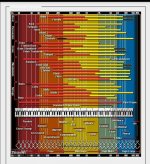
As you can see many instruments end by 5-7K. And a different set of instruments might take over from there.
So the issue of instruments crossover is a lot less of an issue than at 2kHz.
However, a question remains on whether which plays the radio and better a 3" from WAW or an 8" (Whatever you want it called)
Oon
Ooon

Not that it can't sound good (it surely can), but you loose like that the point source sound of a single fullrange driver or waw again as there is a crossover in the higher frequencies who mess with it.
But as alternative for the typical 2 way with a cr at 1.5 to 3kHz it surely can work. I would even go 3 way and add a decent subwoofer to it. Some fullrange drivers are certainly fit to work as a midbass with a wide range of flat response also and can give decent bass to the mid 40's (like my favorite, the Alpair 10 series) because they have decent xmax and a low fs. And if you liberate them from the higher frequencies they will do the lower better, just like when you do it reverse. The Alpair 12PW is also build for that i think. And there are other examples also that can do that. Just get something with a low enough fs and a decenet xmax (4-8mm) and BL for it.
But as alternative for the typical 2 way with a cr at 1.5 to 3kHz it surely can work. I would even go 3 way and add a decent subwoofer to it. Some fullrange drivers are certainly fit to work as a midbass with a wide range of flat response also and can give decent bass to the mid 40's (like my favorite, the Alpair 10 series) because they have decent xmax and a low fs. And if you liberate them from the higher frequencies they will do the lower better, just like when you do it reverse. The Alpair 12PW is also build for that i think. And there are other examples also that can do that. Just get something with a low enough fs and a decenet xmax (4-8mm) and BL for it.
Member
Joined 2009
Paid Member
As you can see many instruments end by 5-7K. And a different set of instruments might take over from there. View attachment 880537
whilst the fundamental produced by an instrument may not reach that high, the harmonics will extend by several octaves and it is the harmonic structure (magnitude and relative phase) that gives each instrument it’s characteristic sound. I imagine preserving the harmonic structure through a XO transition going to be a challenge ?
whilst the fundamental produced by an instrument may not reach that high, the harmonics will extend by several octaves and it is the harmonic structure (magnitude and relative phase) that gives each instrument it’s characteristic sound. I imagine preserving the harmonic structure through a XO transition going to be a challenge ?
Hence the need for a decent relatively flat phase crossover like a Harsch or 1st order. I am using a Harsch XO variant so that the phase is not wrapped like many traditional 2-way speakers that use a 2nd or 4th order LR crossover.
@Cambe,
Tell us more about your speaker. Is it a wide band 5in woofer with a dome tweeter and an 8in woofer on what looks like a back loaded horn? What frequency was your mid to tweet crossover?
@Zman,
We can look at the factory measured polars for the DC130A and see that angle dependency is about around the >5kHz range. Depending on how the tweeter integrates with this region through the crossover, will determine how smooth it is off-axis. I suspect that it might not be as bad as people fear. I certainly don’t hear anything objectionable when I move around a bit - the field seems quite uniform vs frequency. Better than most 5in full range drivers that’s for sure because the highs emanate from a 1in diameter dome.
Attachments
Last edited:
Hi X,
When I had them, I listened to them daily! Mine used the Model O subwoofer which used a 10" woofer. Still also have the Model T subwoofer in another system. Very nice sounding speakers in their day and not bad sounding even by todays standards. However, with the tools we have available to us now this concept can be refined.
Classic monitor designs?
When I had them, I listened to them daily! Mine used the Model O subwoofer which used a 10" woofer. Still also have the Model T subwoofer in another system. Very nice sounding speakers in their day and not bad sounding even by todays standards. However, with the tools we have available to us now this concept can be refined.
Classic monitor designs?
Last edited:
How do you think it would work out with something like an XT19 tweeter with compact flange? Does there need to be a certain amount of offset to make the crossover work, or is this a case of "closer is better"?
E.g. Peerless by Tymphany OT19NC00-04 3/4" Fabric Dome Tweeter 4 Ohm It's extremely clean above 3 kHz, so you get both a cheaper price as well as a smaller package compared to the RST28.
E.g. Peerless by Tymphany OT19NC00-04 3/4" Fabric Dome Tweeter 4 Ohm It's extremely clean above 3 kHz, so you get both a cheaper price as well as a smaller package compared to the RST28.
Yeah I would argue that there's a difference between a woofer and a subwoofer...
I'm doing all three and going four way. STAWAFAIST(Super-Tweeter and Woofer assisted Full-Range and Infra-Sub Technology)
Nothing really out of the ordinary except for letting one full-range cover the whole vocal range from about 600-4000hz, which doesn't seem super common.
I'm doing all three and going four way. STAWAFAIST(Super-Tweeter and Woofer assisted Full-Range and Infra-Sub Technology)
Nothing really out of the ordinary except for letting one full-range cover the whole vocal range from about 600-4000hz, which doesn't seem super common.
ss
I went to look into the graph I put up to see what is really inside. Went to Google it and find out more as it turns out the yellow part of the bar already is the harmonics and the orange is the fundamentals. So even the harmonics will typically end by that frequency...
Oon
Hi,whilst the fundamental produced by an instrument may not reach that high, the harmonics will extend by several octaves and it is the harmonic structure (magnitude and relative phase) that gives each instrument it’s characteristic sound. I imagine preserving the harmonic structure through a XO transition going to be a challenge ?
I went to look into the graph I put up to see what is really inside. Went to Google it and find out more as it turns out the yellow part of the bar already is the harmonics and the orange is the fundamentals. So even the harmonics will typically end by that frequency...
Oon
I have a bit of experience in this field and this is my personal take. I once did 8" SEAS FA22RCZ with a small tweeter and a single cap. Also an Audio Nirvana 15" with a ribbon tweeter. But now I mostly deal with 3" driver ( Faitalpro) and a subwoofer or woofer arrangement.
The 3" when used to play the mids gives a more detailed mids with better clarity. The treble for the Faitalpro can match quite a few tweeters out there. If coated with a layer of visaton LTS50 on the cone sound improves further. But it is probably not as good as the best tweeter out there. I find if it supplemented by a tweeter the sound is even better. However the tweeter must about 6db more efficient and the tweeter must up or rear firing. The speaker is toed in to give a nice big sweet spot while the extra tweeter provides air and projects a feeling of a big soundstage.
The large speakers tend to have a weighter presence and has a nice way of filling in the room with music. The tweeter should be forward facing. However 8"full range tends to require a much larger cabinet than a 8" woofer. The challenge of doing such an arrangement is dealing with cone breakup. Some drivers do break up quite nastily and need to be crossed quite low. Since that time, there are now many mid bass that can go 10kHz or more. The SB acoustics aluminium mid woofers go up to 20kHz.
I had been putting off a project for Carbon fibre Dayton CF120 for a long time. it has frequency response to about 10K. Bought it a few years back...
Maybe I will try it on this way.
Oon
The 3" when used to play the mids gives a more detailed mids with better clarity. The treble for the Faitalpro can match quite a few tweeters out there. If coated with a layer of visaton LTS50 on the cone sound improves further. But it is probably not as good as the best tweeter out there. I find if it supplemented by a tweeter the sound is even better. However the tweeter must about 6db more efficient and the tweeter must up or rear firing. The speaker is toed in to give a nice big sweet spot while the extra tweeter provides air and projects a feeling of a big soundstage.
The large speakers tend to have a weighter presence and has a nice way of filling in the room with music. The tweeter should be forward facing. However 8"full range tends to require a much larger cabinet than a 8" woofer. The challenge of doing such an arrangement is dealing with cone breakup. Some drivers do break up quite nastily and need to be crossed quite low. Since that time, there are now many mid bass that can go 10kHz or more. The SB acoustics aluminium mid woofers go up to 20kHz.
I had been putting off a project for Carbon fibre Dayton CF120 for a long time. it has frequency response to about 10K. Bought it a few years back...
Maybe I will try it on this way.
Oon
Member
Joined 2009
Paid Member
I love the FF85WK, has Dave's coating and EnABL dots, with OB rythmik subs. It does realistic voices really well. Not that I've heard the drivers without the coating, but I also stopped messing with speakers for a while after getting these going 
Oon, thanks for the ideas, aiming the tweeter with these smaller FR's that can do HF pretty well already
Oon, thanks for the ideas, aiming the tweeter with these smaller FR's that can do HF pretty well already
- Status
- This old topic is closed. If you want to reopen this topic, contact a moderator using the "Report Post" button.
- Home
- Loudspeakers
- Full Range
- FAST or STAFT (WAW or STAW) Which is Better?
